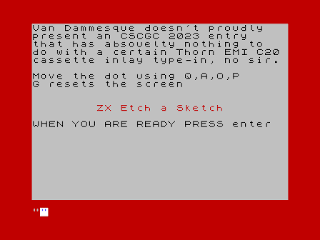We had Next A Sketch, next up we have Etch A Sketch.
Oh crap. Another Etch A Sketch non-game. What on earth can I think to say that I haven't covered already?
Warning: This review might be sketchy. But maybe not. Perhaps you will like it and it will be etched on your memory for years to come.
While Jim's entry focused on the most complicated user experience possible, packed with unnecessary features, knobs and whistles, Van Dammesque entry is at the other end of the spectrum, and is about a basic as it gets.
The keys are QAOP, and G to clear the screen. Just like the real thing, the pointer stays in the same position when the screen is reset, and that is a touch of quality. The game is written in basic, and runs a little too slow for my taste. However the game is smooth and doesn't flicker.
There is no loading screen, nor are there any sound effects. This is a simple-as-it-gets non-game. That's it, nothing more to say. Review over.
...Intermission...
Well, not quite, because there is a bit of a story here, and its one that I suspect was the inspiration of this recent surge in Etch A Sketch submissions....
So it's a sort of unboxing video for nerds (like me), where someone opens a new from old stock cassette tape for the first time and seems to discover some code on the inlay for a VIC 20 and a ZX81. Yep you guessed it, the code is a simple Etch A Sketch game.
Both versions are attribute based in draw a chunky line, although I'd say the zx81 version is superior, with a thinner line, although it do does flicker somewhat. At this point I am going to assume you just watched the above video, or else don't care, in either case I will not describe it further.
So Van_Dammesque has made a further refinement, as he has made a game that plots a pixel at a time. So this must be the definitive version of this program - as it is as true to the original as possible on the Spectrum?
The only way to go further now is to create a edge connector peripheral with rotary encoder knobs to control the movement, and an inbuilt sensor that clear the screen when you turn the spectrum upside down, and shake it.
Summary
Well, its a lot easier to use than Jim's version, and it is also arguably more true to the original concept than his too. However, it is not really very fun to play. Still, a cool little basic program, with an interesting back story.



Comments
Post a Comment